|
BULB LOG 12 - 21st March 2007
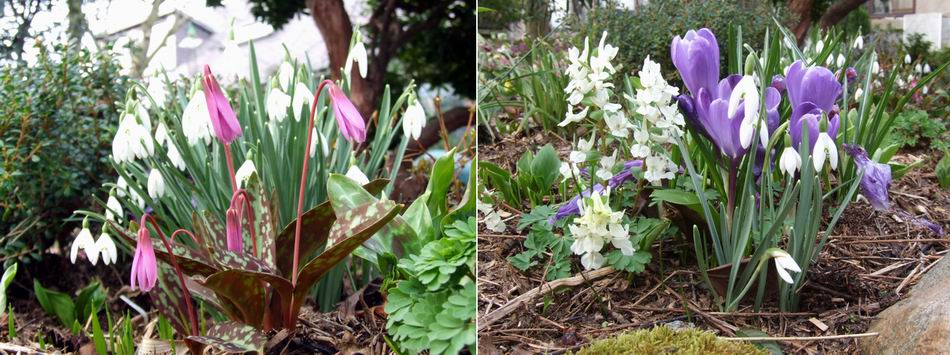
Erythronium, Galanthus, Crocus, Corydalis
For a few bright sunny days it seemed like spring had arrived and winter was behind us but we can never rely on the weather. Today, Monday, the wind is blowing down from the frozen north bring some heavy snow showers but luckily with the wind and sunny spells between, the snow is not lying in Aberdeen. On a better day than today I took some pictures of the bulbs that are appearing all over the garden. Snow drops are still opening as are crocus and now, corydalis and erythronium are starting to appear in numbers. Luckily all these flowers are tough and can survive the freezing conditions without showing too much damage.
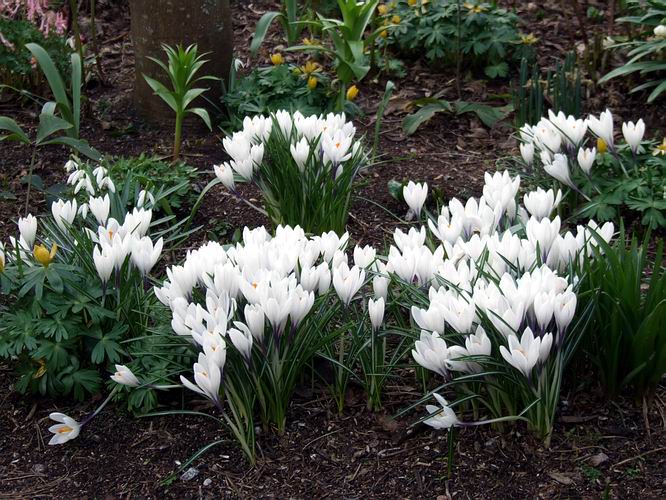
Crocus vernus
I showed a nice white selection raised from a seedling found growing close to this group of one of the larger selections of Crocus vernus. This is one of the many forms that are used in public mass displays, as a group they are among the largest forms of vernus I have seen with this white one being modest in size compared to some. Just because a bulb is common and widely grown it does not stop it being a great plant and we must take care not to let rarity beguile us and turn into plant snobs.
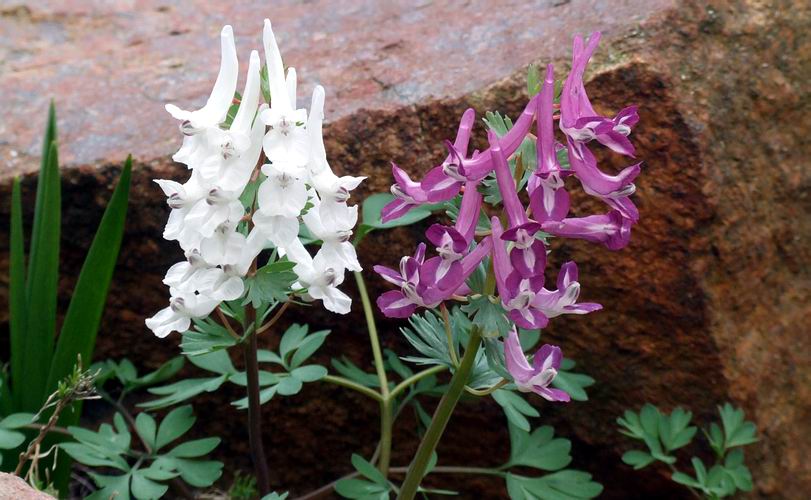
Corydalis seedlings
Here is a nice pair of Corydalis seedlings flowering in a raised bed. These are the result of a pot of seedlings that I planted out because I had lost the label.
For many years now we have stopped using labels in open beds around the garden, they always disappear or become illegible and, except for in botanic gardens where they are needed, I think they are a distraction from the aesthetic. So we have to either remember the plant's name or go back to the books and work it out - this is a good exercise in memory for us. Now back to the corydalis seedlings, they look like C. solida, possibly ssp incise; I now have the task of going back to the book and confirming this identification. It is interesting that one is white and one is purple and this leads me to wonder if the seed is from C. solida incisa alba. One thing I am sure that you will agree with is that not knowing their precise identity does not distract from the beauty of these plants, but, if you want to go and get a plant like this you do need the name and that is when names become important.
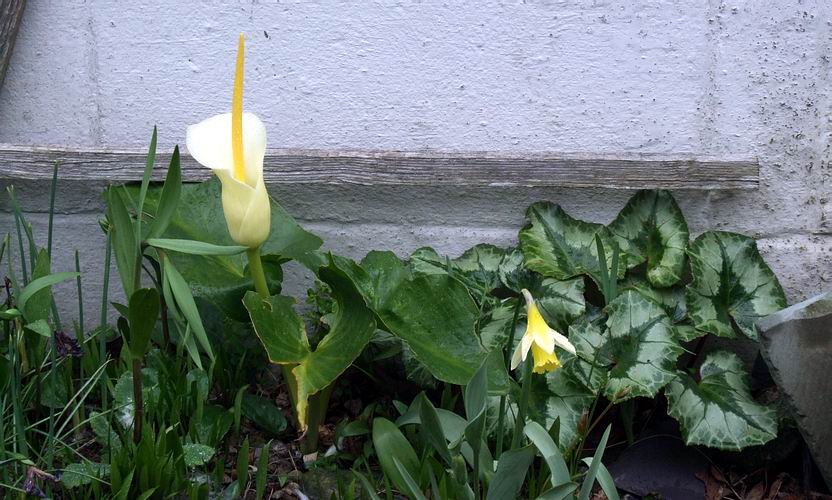
Arum creticum
I used to have three large pots of Arum creticum and we always took one to the SRGC Shows, Edinburgh or Stirling, depending on the timing. I do not know if you have ever smelt the scent from this plant but it is not very plaesent to say the least and to have share a car with it for a two hour journey was not the best experience so we stopped taking it. With the reorganising I have done in the bulb houses and the move to square plastic pots I now only keep one corm under glass; most of the rest went to new homes and I planted a few in the garden to see how they would do in our cold wet conditions. Most of those I planted did not survive for more than a few years, they rotted off in the summer but this one survived in a well drained sunny south facing bed at the bottom of our kitchen wall and has flowered for three years in a row. To the right of the picture you can see the leaves of Cyclamen africanum another unlikely survivor in our cool wet northern climate.
It just shows that you never know what will survive in your garden until you try it - the plants cannot read the books and so do not know they are not supposed to be hardy here - by adapting the soil conditions and giving them a favourable aspect they can often cope with the weather.
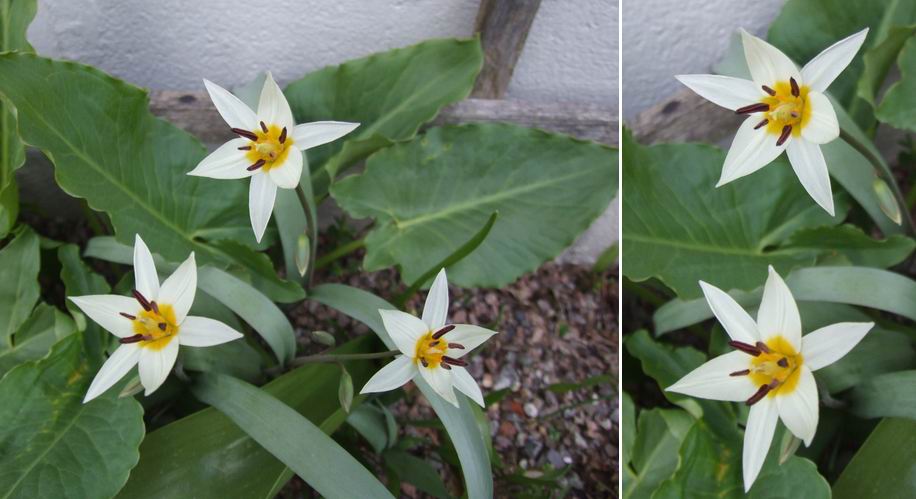
Tulipa turkestanica
Tulipa turkestanica is also flowering in the same bed but it does not require such treatment as it is one of the tulips that grows well for us and flowers in other areas of the garden. This is the commercial form of Tulipa turkestanica which apparently seems to differ from many wild populations in having dark anthers; I have only ever had the cultivated form.
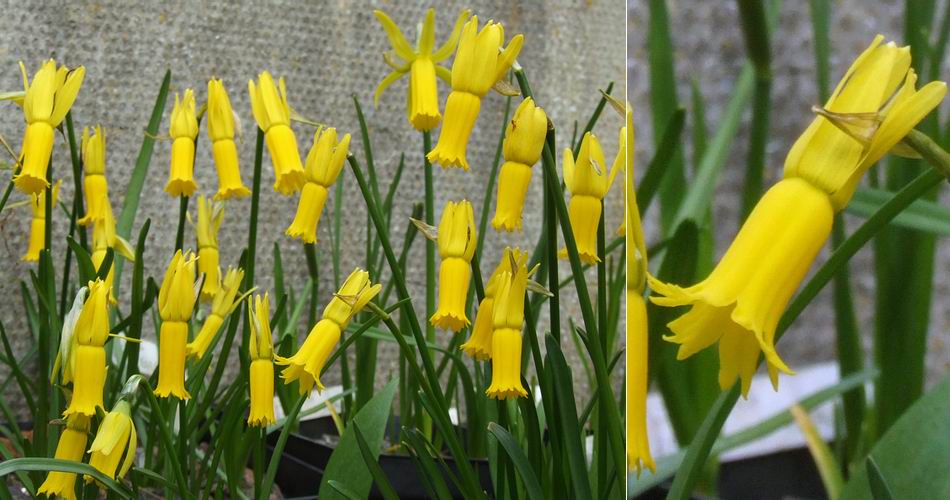
Narcissus cyclamineus
Narcissus cyclamineus flowers are everywhere and I continue to raise them from our own seed every year because I am determined to have them everywhere. When you look at a pot of seedlings they all appear superficially the same but when you look closely you can see quite a degree of variation in the shape of the flowers. The one on the right stands out as it has a very flared frilly trumpet, can you spot it in the big picture?
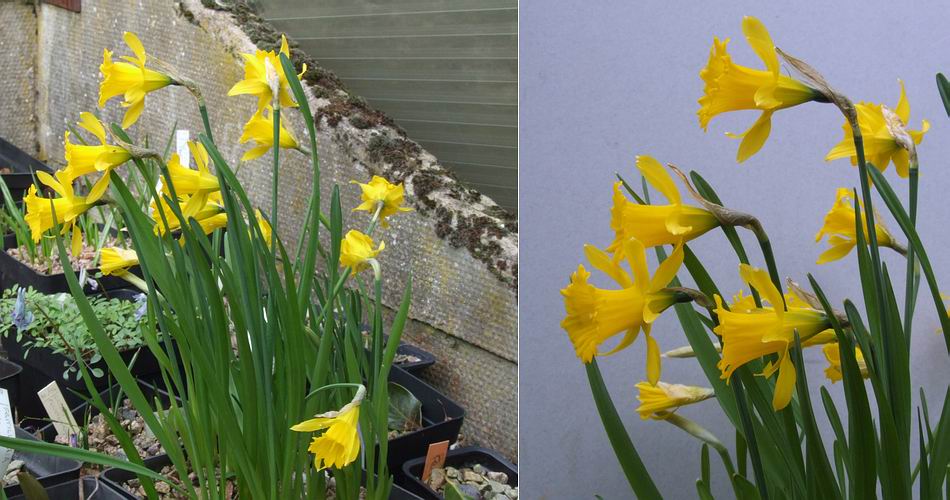
Narcissus perez-chiscanoi
Referring back to bulb log 9 this year when I showed a hybrid between Narcissus cyclamineus and Narcissus perez-chiscanoi - here is this year's flowering of perez-chiscanoi just opened.
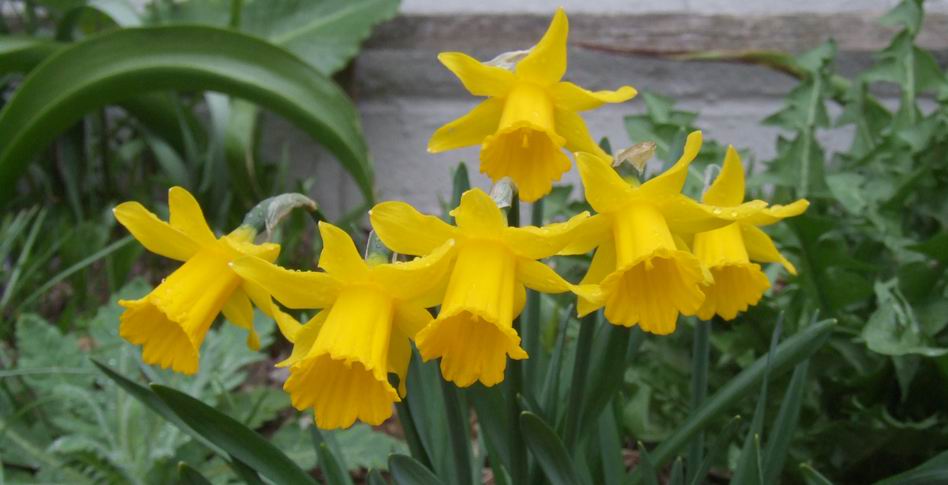
Narcissus 'Small Talk'
There are many excellent Narcissus hybrids available that are perfectly hardy in the garden and should multiply well; such as Narcissus 'Small Talk'.

Narcissus 'Gipsy Queen'
If you prefer them pale lemon yellow not golden yellow then look out for Narcissus 'Gipsy Queen'.
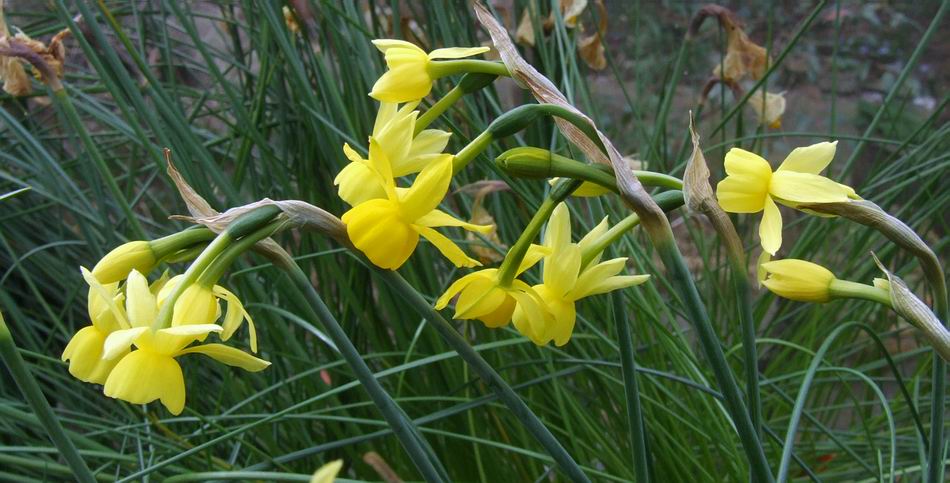
Narcissus incurvicervicus
Under glass, a naturally occurring hybrid Narcissus incurvicervicus is flowering nicely. It is intermediate between its parents Narcissus fernandesii and N. triandrus var cernuus and I find that it increases steadily.
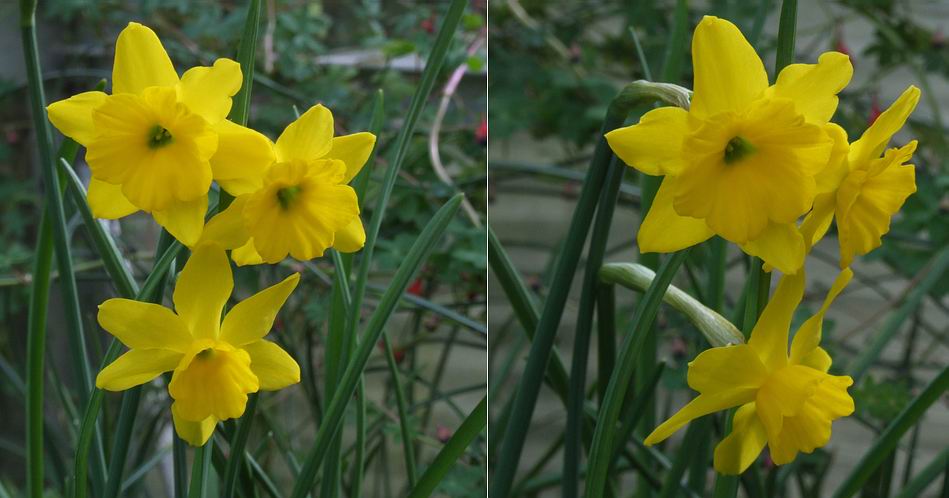
Narcissus rupicola ssp marvieri
I have been greatly enjoying the beautiful pictures of Narcissus in the wild that Rafa has shared with us in the SRGC forum pages and none have been more beautiful and instructive than a recent picture of a clump of Narcissus rupicola growing in a rock crevice. The plant I show is Narcissus rupicola ssp marvieri and differs from the species in that the corona is generally larger and protrudes more and I have found that while it needs plenty water as its leaves are growing, it dislikes being kept too wet for any length of time. Not surprising when we see the habitat it has - well drained rock ledges and crevices.

Narcissus jonquilla
The jonquilles also coming out under glass a good bit ahead of their counterparts in the garden. They have fabulous scent and they make for a very dramatic display even though they run to height in our poor light.

Narcissus jonquilla close up
I could not resist this close up that gives a good impression of the impact they have when I walk into the bulb house.
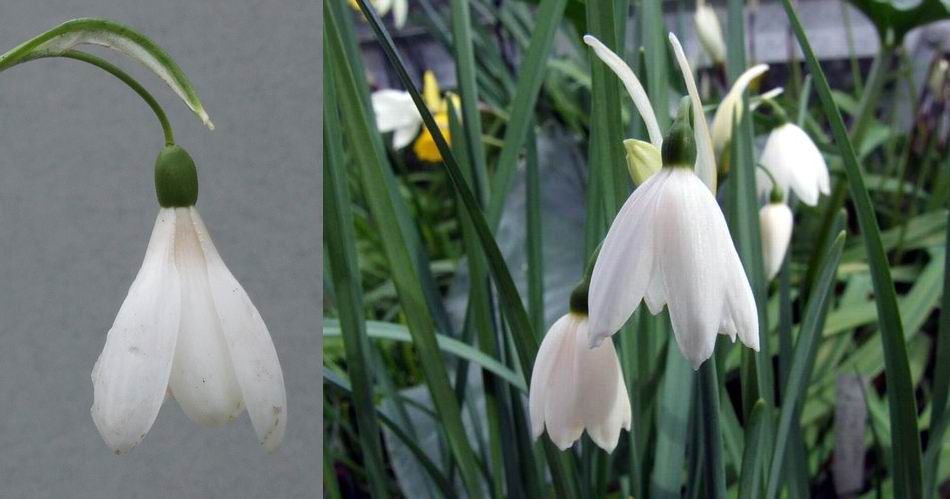
Galanthus and Leucojum tingitanum
When is a snowdrop not a snowdrop? When it is a snow flake like Leucojum tingitanum, which is now called Acis tingitanum. But compare it to the galanthus that I just received a month ago, on the left, where all the floral segments are the same size with no green markings on the petal at all - Galanthus, Leucojum, Acis??
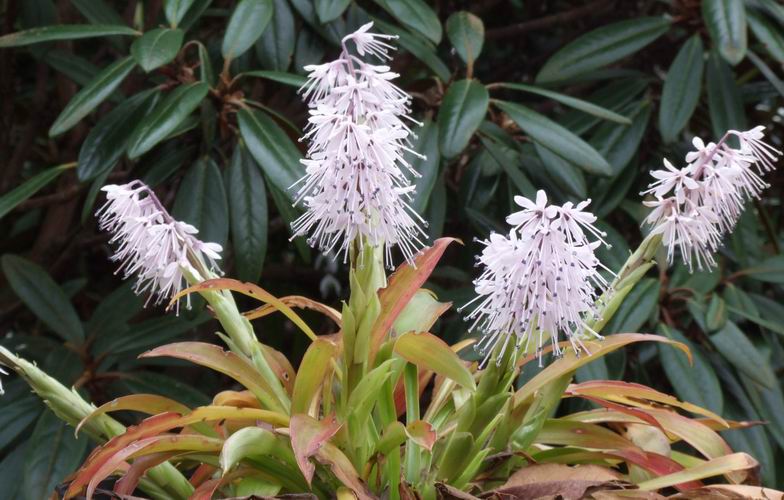
Ypsilandra thibetica
Not a bulb but a nice plant that fits in well in our garden with its interesting flowers.

Lily
Not everything is as it seems and as you can see this plant is still in its pot which just sits on a slab all year, this year I will plant it out. As you can see I am being aided by a new Lily, new to us any way. Let me introduce Lily, an 8 year old West Highland Terrier that we have just given a home to. She is just the best wee dog, she likes to help me in the garden and does not walk on the beds but does sometimes get between the camera and the plant.
^ back to the top ^
|

